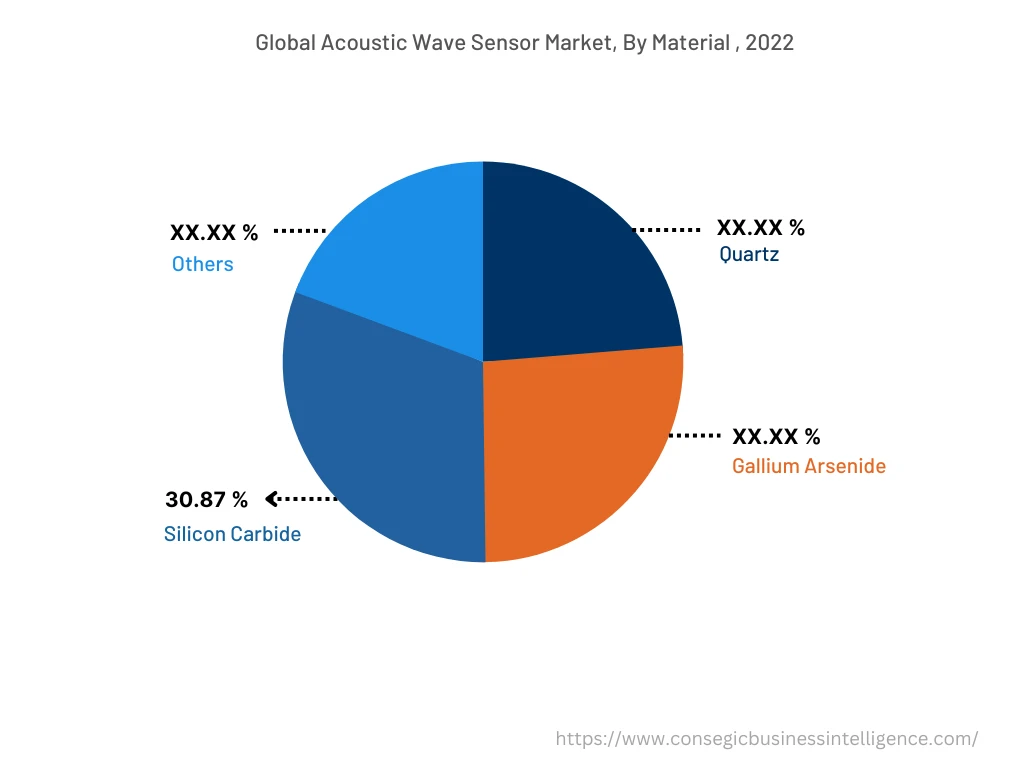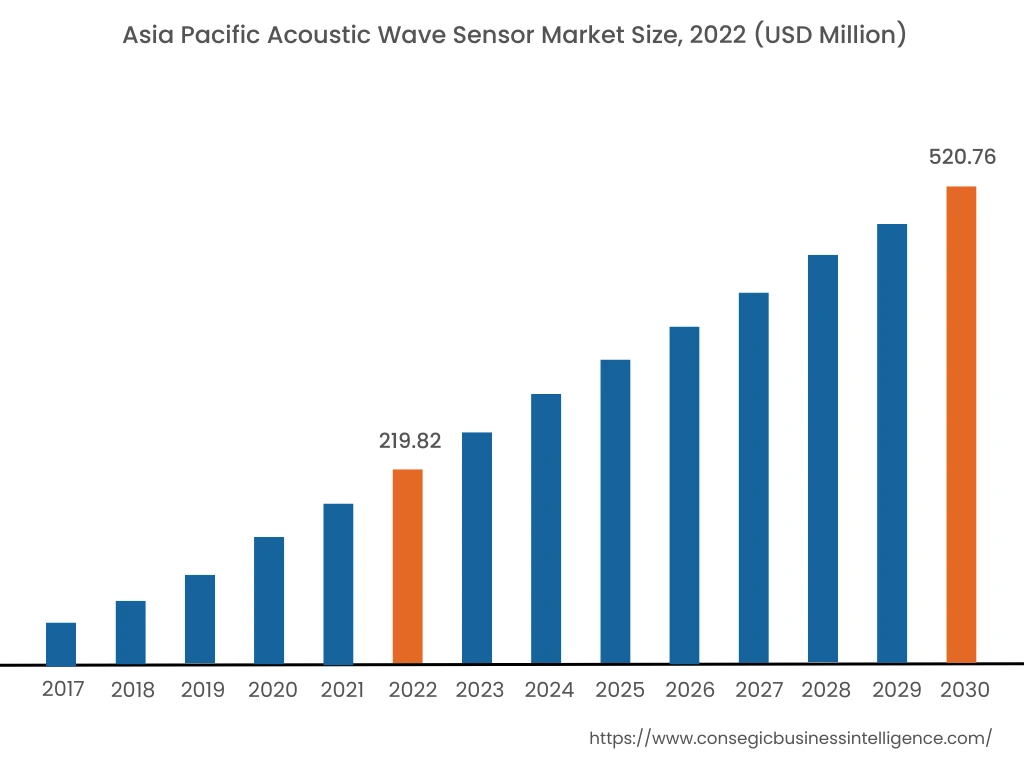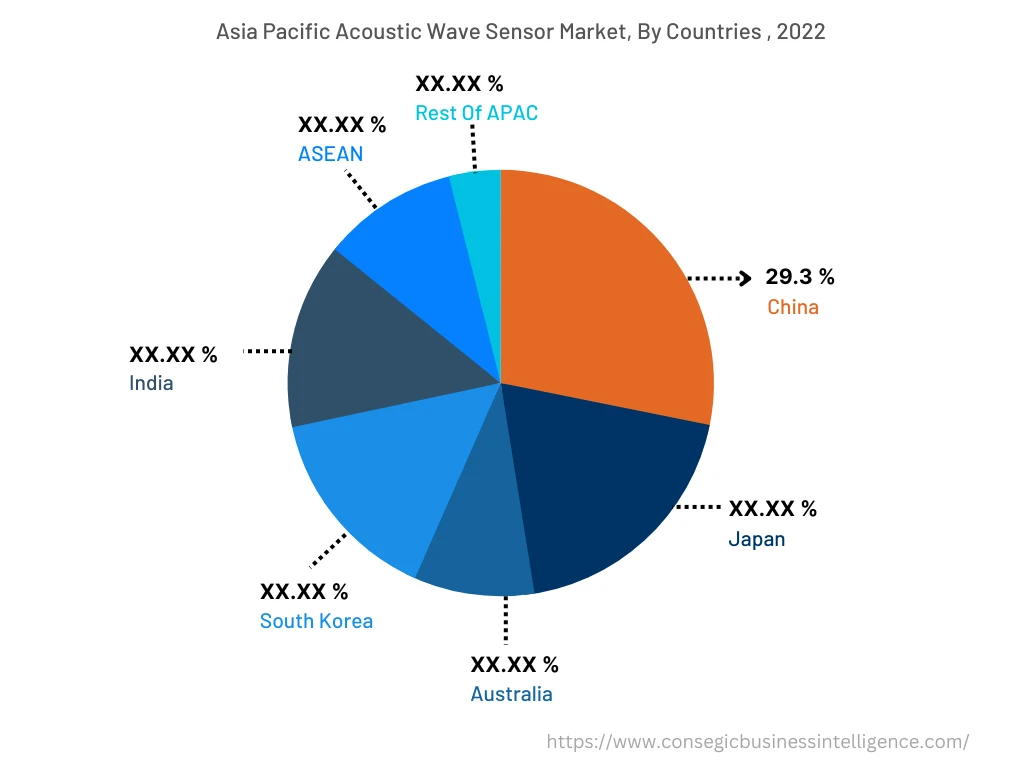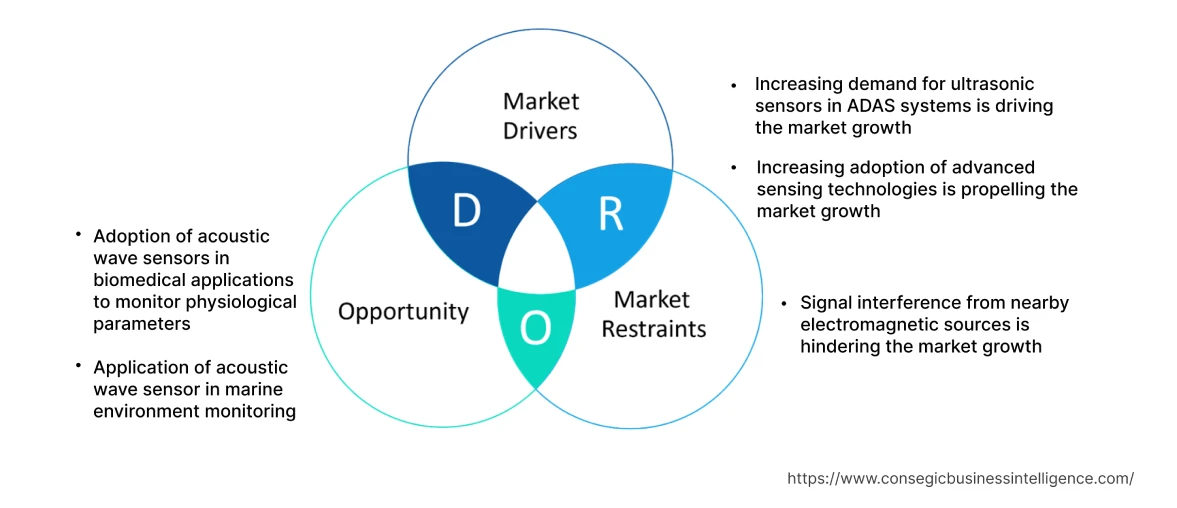Acoustic Wave Sensor Market Size :
Acoustic Wave Sensor Market Size is estimated to reach over USD 2,003.69 Million by 2030 from a value of USD 872.98 Million in 2022, growing at a CAGR of 11.2% from 2023 to 2030.
Acoustic Wave Sensor Market Scope & Overview:
An acoustic sensor, also known as a sound sensor, is a device designed to detect and measure sound waves in the environment. They convert sound energy into electrical signals that are processed or analyzed by electronic systems. Acoustic wave propagates through the surface of the material resulting in a change in the velocity or amplitude of the wave. As a result, changes in velocity are monitored by measuring the frequency or phase characteristics of the sensor corresponding physical quantity being measured. Thus, they are used in automotive applications, medical applications, and industrial and commercial applications for measuring parameters such as temperature, pressure, torque, and mass.
Acoustic Wave Sensor Market Insights :
Key Drivers :
Increasing demand for ultrasonic sensors in ADAS systems is driving the market
The increasing demand for ultrasonic sensors in automotive applications such as Advanced Driver-Assistant Systems (ADAS) is accelerating the market. Moreover, ultrasonic sensors are capable of sensing vibrations occurring in the sound waves to detect nearby objects present on the road. For instance, Ultrasonic sensors utilize sound waves above 20 kHz range to detect objects in proximity. Moreover, ultrasonic sensors are widely used in ADAS systems, specifically for parking assist where 4–16 sensors are used to detect nearby objects while parking a vehicle. For instance, in May 2023, Valeo manufactured 1 million units of ultrasonic sensors for utilization in ADAS systems, for applications including object detection and other vehicles present on the road. Consequently, the market trends analysis depicts that the increasing adoption of acoustic sensors in ADAS systems to avoid collisions on roads is accelerating the acoustic wave sensor market growth.
Increasing adoption of advanced sensing technologies is propelling the market
The distributed fiber optic vibration technology produces the Rayleigh back-scattered light by introducing laser light into the fiber cables. Therefore, the ability of the distributed fiber optic vibration technology to provide high spatial resolution and long-range vibration detection is driving the market. The aforementioned technology operates in a fully distributed manner with remote accessibility, high sensitivity, and immunity in comparison to traditional mechanical or electrical sensors. For instance, in September 2021, NTT Corporation demonstrated a technology for the measurement of vibrations in optical fibers with extremely high accuracy to detect environmental vibrations in optical fiber cables for communication purposes. Therefore, analysis of market trends shows that the increasing adoption of advanced sensing technologies for the detection of sound vibrations is driving the acoustic wave sensor market growth.
Key Restraints :
Signal interference from nearby electromagnetic sources is hindering the market
Acoustic sensors are susceptible to signal interference from other nearby acoustic sources or electromagnetic sources. The disturbance from nearby electromagnetic sources degrades the performance of the circuit resulting in sensor failure. As a result, the interference affects the accuracy and reliability of the sensor's output, requiring advanced signal processing techniques or shielding measures. Therefore, market analysis shows that a reduction in the performance of acoustic sensors due to signal interference from electromagnetic sources is hindering the acoustic wave sensor market demand.
Future Opportunities :
Adoption in biomedical applications to monitor physiological parameters
The adoption of medical applications for monitoring physiological and pathological conditions such as heart and respiratory sounds is expected to drive the acoustic wave sensor market during the forecast period. Traditional devices such as stethoscopes are replaced by new miniaturized devices such as Microelectromechanical Systems (MEMS). MEMS systems can detect the vibrational content of acoustic signals to provide information on the amplitude and frequency of the waves. Therefore, the analysis of market trends portrays that their adoption in medical applications is expected to drive acoustic wave sensor market opportunities during the forecast period.
Application in marine environment monitoring propels the acoustic wave sensor market
The application of acoustic sensors in marine environment monitoring is expected to present potential opportunities for the market during the forecast period. They are expected to detect various parameters such as water quality and noise levels that are essential to maintain marine life. Moreover, they are deployed to measure the level of pollutants and contaminants present in water bodies, which is a necessary measure required for the safety and security of marine life. Thus, as per the market trends analysis, the aforementioned reasons drive the acoustic wave sensor market opportunities.
Acoustic Wave Sensor Market Report Insights :
| Report Attributes | Report Details |
| Study Timeline | 2017-2030 |
| Market Size in 2030 | USD 2,003.69 Million |
| CAGR (2023-2030) | 11.2% |
| By Material | Quartz, Gallium Arsenide, Silicon Carbide, and Others |
| By Sensing Parameter | Temperature, Pressure, Humidity, Torque, Viscosity, and Others |
| By Wave Type | Surface Wave Acoustic Sensor and Bulk Wave Acoustic Sensor |
| By End-User | Automotive, Aerospace & Defense, Consumer Electronics, Healthcare, Industrial, and Others |
| By Region | Asia-Pacific, Europe, North America, Latin America, Middle East & Africa |
| Key Players | Murata Manufacturing Co., Ltd., KYOCERA Corporation, Panasonic Corporation, APITech, Bürkert GmbH & Co. KG, CeramTec GmbH, Columbia Research Laboratories, Microchip Technologies Inc., Dytran Instruments Incorporated, Siemens |
Acoustic Wave Sensor Market Segmental Analysis :
By Material :
Based on the material, the market is segregated into quartz, gallium arsenide, silicon carbide, and others. The Silicon Carbide segment accounted for the largest revenue of 30.87% in the year 2022 of the global acoustic wave sensor market. Silicon Carbide (SiC) has great importance as a material for Micro-Electromechanical Systems (MEMS) due to its high mechanical properties such as excellent wear resistance, high hardness, and the ability to operate at high temperatures of up to 500 °C. Therefore, SiC is well-suited for manufacturing acoustic sensors, as the material is available in bulk or as a thin film of silicon (Si) substrate.
The Gallium Arsenide segment is expected to register the fastest CAGR during the forecast period. It is a widely used semiconductor material used for manufacturing acoustic sensors to sense various parameters such as temperature, pressure, and mass. Moreover, GaAs acoustic sensors offer high sensitivity, low noise, and high-frequency response well-suited for gas sensing, biosensing, and chemical sensing applications. Consequently, the segment trends analysis shows that the ability of GaAs sensors to detect the aforementioned parameters with high accuracy and sensitivity is driving the acoustic wave sensor market trends.

By Sensing Parameter :
Based on the sensing parameter, the market is segmented into temperature, pressure, humidity, torque, viscosity, and others. Temperature segment accounted for the largest revenue share in 2022 of the total acoustic wave sensor market share. Temperature acoustic sensors are used for sensing temperature by detecting the speed of sound in a material as the temperature changes. The sensors measure the time of flight of acoustic pulses to detect temperature variations in an object or a material. Therefore, analysis of segment trends shows that the ability of temperature sensors to detect temperature variations with high accuracy and precision is proliferating acoustic wave sensor market demand.
The humidity segment is anticipated to register the fastest CAGR during the forecast period. Acoustic sensors play a crucial role in measuring humidity in the manufacturing industry, especially in the paper and textiles industry. Sound waves are highly affected by the humidity in the air. As a result, researchers are performing experiments for comparative analysis of humidity by transferring sound pulse through the air. Moreover, the sensors are made to be integrated into a humidity control system that measures humidity accurately and efficiently. For instance, in January 2023, Sensirion AG launched an analog humidity sensor for industrial applications and harsh environments where high noise levels are used to measure the level of humidity. Therefore, the application of sensors in environment monitoring applications is driving the acoustic wave sensor market trends.
By Wave Type :
Based on the wave type, the market is bifurcated into surface wave acoustic sensors and bulk wave acoustic sensors. The surface wave acoustic sensor segment accounted for the largest revenue share in 2022 of the acoustic wave sensor market share. Surface wave acoustic sensors utilize acoustic waves that propagate along the surface of a solid material, such as a piezoelectric substrate. As a result, surface wave sensors are widely used in wireless communication systems, such as filters, resonators, and delay lines. Moreover, the ability of surface wave acoustic sensors to operate at high frequencies and offer high sensitivity in the aforementioned applications is accelerating the acoustic wave sensor market expansion.
The bulk wave acoustic sensor segment is anticipated to emerge as the fastest-growing segment during the forecast period. The ability of bulk acoustic sensors to handle high power levels and operate at lower frequencies is driving the segment. It involves the propagation of acoustic waves through the bulk or volume of a material. Moreover, they are characterized by their ability to handle high power levels and operate at lower frequencies. Furthermore, the application of bulk wave acoustic in NDT applications for flaw detection, material characterization, and thickness measurement is proliferating the acoustic wave sensor market.
By End-User :
Based on the end-user, the market is divided into automotive, aerospace & defense, consumer electronics, healthcare, industrial, and others. The consumer electronics segment accounted for the largest revenue share in the year 2022. Consumer electronics devices such as smartphones, tablets, headphones, smart speakers, and gaming consoles, utilize acoustic sensors for voice control, audio recording, noise cancellation, and sound enhancement. Moreover, the application of acoustic sensors in camera systems to locate and characterize sound sources is accelerating the growth of the market. For instance, in March 2023, Sony Semiconductor Solutions Corporation (SSS) announced to launch of a new direct time-of-flight depth sensor called IMX611 to improve photon detection efficiency for distance measurement applications. Therefore, the growing demand for voice-controlled devices and immersive audio experiences drives the adoption of acoustic sensors in consumer electronics devices.
The automotive segment is expected to register the fastest CAGR during the forecast period. Acoustic sensors are utilized in vehicles for various applications, including noise cancellation, voice recognition, in-cabin communication, and advanced driver-assistance systems (ADAS). Therefore, acoustic sensors contribute to improving sound quality, enhancing communication capabilities, and enhancing safety features in vehicles.
By Region :
The regional segment includes North America, Europe, Asia Pacific, the Middle East and Africa, and Latin America.

North America accounted for the largest revenue share in the year 2022. The increasing adoption of acoustic wave sensors in the healthcare industry in North America is driving the acoustic wave sensor market. As per the acoustic wave sensor market analysis, they are utilized in medical devices, telehealth systems, and healthcare facilities for applications such as patient monitoring, telemedicine, and diagnostic imaging. Moreover, the deployment of advanced sensing technologies in the region is driving the market. For instance, in April 2021, AP Sensing launched next-generation acoustic sensing technology called Distributed Acoustic Sensing (DAS) for monitoring infrastructures such as power cables, pipelines, and railways. Thus, continuous advancements in sensing technology are driving the growth of the regional market.
The Asia-Pacific region accounted for a revenue share of USD 219.82 million in 2022 and is expected to reach USD 520.76 million in 2030, registering a CAGR of 11.7% during the forecast period. Additionally, in the region, China accounted for the largest revenue of 29.3% in the year 2022. The Asia-Pacific region has a strong industrial base with a focus on automation and manufacturing. Acoustic sensors are widely used in industries for condition monitoring, fault detection, and process control applications. Additionally, the growing adoption of consumer electronics devices such as smartphones, laptops, and tablets in the region is driving the growth of the acoustic wave sensor market. They play a crucial role in voice control systems in consumer electronics, resulting in the growth of the acoustic wave sensor market.

Top Key Players & Market Share Insights:
The acoustic wave sensor market is characterized by the presence of major players providing advanced sensing technologies for sensing parameters such as temperature, pressure, torque, and humidity. Key players operating in the market are adopting several business strategies such as research and development (R&D), product innovation, and application launches have accelerated the growth of the acoustic wave sensor market. Key players in the acoustic wave sensor industry include-
- Murata Manufacturing Co., Ltd.
- KYOCERA Corporation
- Bürkert GmbH & Co. KG
- APITech
- CeramTec GmbH
- Columbia Research Laboratories
- Microchip Technologies Inc.
- Dytran Instruments Incorporated
- Siemens
Recent Industry Developments :
- In November 2022, TDK Corporation introduced industrial motion sensors called IIM-46234 and IIM-46230 for the detection of fault tolerance in high-performance navigation applications.
- In April 2022, Bandweaver Technology launched a Perimeter Intrusion Detection System called ZoneSentry to detect and alert to the vibrations associated with intrusion events.
Key Questions Answered in the Report
What is acoustic wave sensor? +
Acoustic wave sensors are the equipment that convert sound energy into electrical signals that is processed or analysed by electronic systems. Acoustic wave sensors are used to sense parameters such as temperature, pressure, torque, and humidity.
What specific segmentation details are covered in the Acoustic Wave Sensor report, and how is the dominating segment impacting the market growth? +
The report consists of segments including material, sensing parameter, wave type, and end-user. Each segment has key dominating sub-segment being driven by the industry trends and market dynamics. For instance, by wave type has witnessed surface wave acoustic sensor as the dominating segment in the year 2022, due to its ability to sense different parameters along the surface of a solid material.
What specific segmentation details are covered in the Acoustic Wave Sensor market report, and how is the fastest segment anticipated to impact the market growth? +
The report consists of segments including material, sensing parameter, wave type, and end-user. Each segment is projected to have the fastest-growing sub-segment being fuelled by industry trends and drivers. For instance, by end-user segment has witnessed automotive as the fastest-growing segment during the forecast period due to the increasing adoption of acoustic sensors in ADAS systems.
Which region/country is anticipated to witness the highest CAGR during the forecast period, 2023-2030? +
Asia-Pacific region is expected to register fastest CAGR growth during the forecast period due to the increasing adoption of acoustic wave sensors in manufacturing industry in Asia-Pacific.


